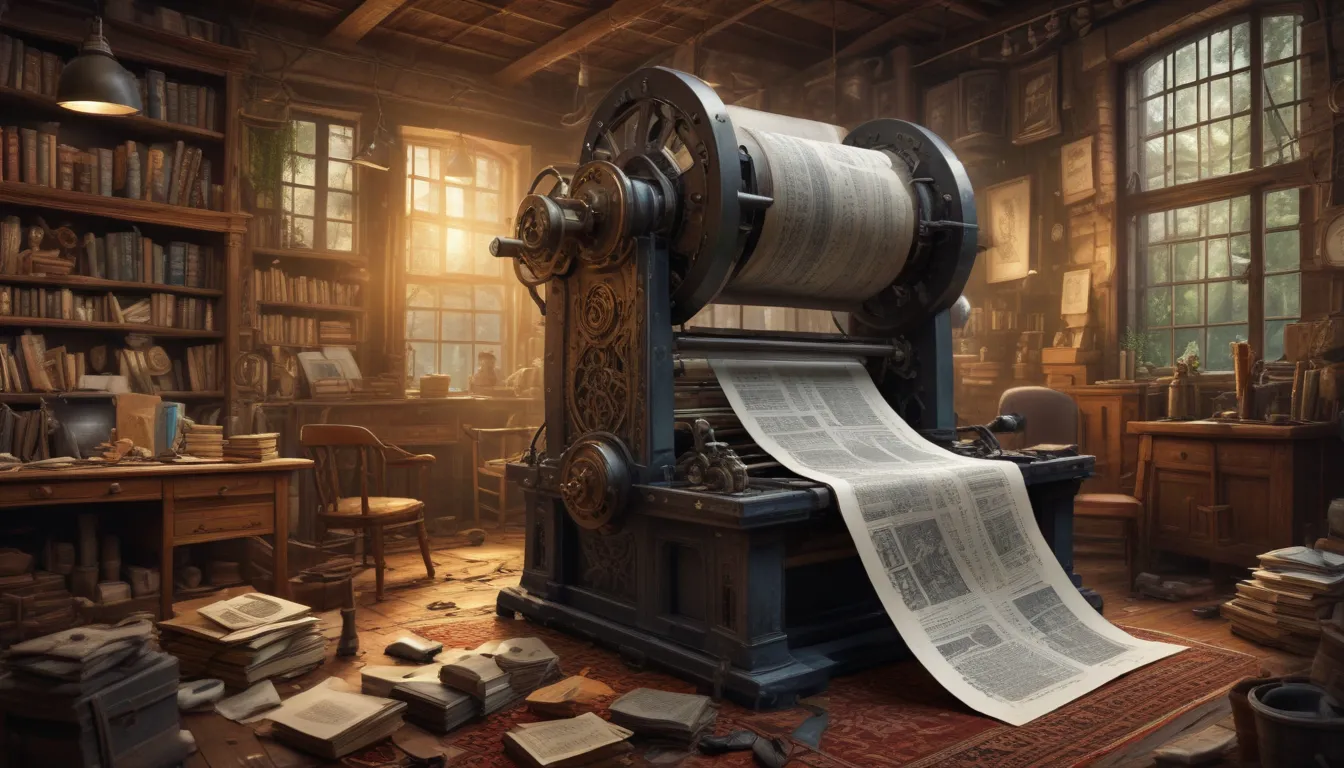The images in our articles may not match the content exactly. They are used to grab your attention, not to show the exact details in the text. The images complement the text but do not replace it.
Are you curious about the transformative journey of the printing press from its humble beginnings to its pivotal role in shaping the modern world? The story of the printing press is nothing short of remarkable, revolutionizing the way knowledge was shared, empowering the masses, and igniting the spark of new ideas. As we delve into the past, let’s uncover 18 of the most intriguing facts about the printing press that forever changed our world.
The Genesis of the Printing Press
In the mid-15th century, a visionary inventor by the name of Johannes Gutenberg unveiled a revolutionary creation that would alter the course of history. Born out of Mainz, Germany, Gutenberg’s printing press transformed the laborious process of hand-copying books into a swift and efficient method of mass production, democratizing access to knowledge and information.
- Johannes Gutenberg, a multifaceted individual encompassing roles as a blacksmith, goldsmith, printer, and publisher, conceived the printing press around the year 1440.
- The crux of Gutenberg’s invention lay in the utilization of movable type, crafted from a durable alloy. This pioneering technique allowed for the swift assembly of words and sentences, expediting the printing process to an unprecedented level.
The Societal Impact of the Printing Press
The emergence of the printing press reverberated across society, leaving an indelible mark on culture, education, and the dissemination of ideas. It played a pivotal role in propelling the Renaissance, the Reformation, and the Scientific Revolution, while simultaneously fostering a surge in literacy rates throughout Europe.
- The inaugural major work to be printed using mass-produced movable type was the renowned Gutenberg Bible, also referred to as the 42-line Bible, completed circa 1455.
- Often credited with catalyzing the development of the Renaissance, the Reformation, and the Age of Enlightenment, the printing press served as a conduit for the proliferation of groundbreaking concepts.
- The onset of the printing press heralded a significant surge in literacy levels across Europe, as books became more affordable and accessible to a wider audience.
The Evolution of Printing Technology
As time progressed, the printing press underwent a series of technological advancements, giving rise to novel printing methods and machinery. These innovations continued to redefine how information was disseminated and consumed by the masses.
- The advent of steam-powered printing presses in the 19th century revolutionized the speed and efficiency of printing operations.
- Groundbreaking inventions such as the Linotype machine in 1884 and the Monotype machine in 1887 automated the type-setting process, further expediting printing tasks with enhanced cost-effectiveness.
The Global Dissipation of the Printing Press
The influence of the printing press transcended continental boundaries, permeating diverse cultures and societies worldwide. Its impact was not confined solely to Europe but resonated across continents, leaving an indelible imprint on human history.
- While the printing press reached the Ottoman Empire in the late 15th century, its initial implementation was hampered due to apprehensions regarding knowledge control.
- In East Asia, movable type printing had already been in existence for centuries before Gutenberg’s innovation, albeit with limited impact compared to Europe due to the complexity of characters in languages like Chinese.
- The establishment of the first printing press in the Americas in Mexico City in 1539 marked a significant milestone, profoundly influencing information dissemination in the New World.
The Printing Press in Contemporary Society
Even amidst the digital era, the enduring legacy of the printing press remains palpable. Its inception laid the groundwork for the widespread circulation of information, a concept that continues to shape our contemporary landscape.
- The principles underpinning the printing press persist in modern printing technologies, encompassing digital printing and 3D printing methodologies.
- The democratization of information engendered by the printing press foreshadowed the evolution of the internet and social media platforms, where information is freely disseminated on a global scale.
- Despite the burgeoning prevalence of digital media, physical books retain their enduring popularity, underscoring the lasting impact of Gutenberg’s invention on how individuals engage with literature and information.
- Recognized by UNESCO as one of the most significant documents in history, the Gutenberg Bible symbolizes the global importance of the printing press.
- Positioned as a pivotal milestone in human history parallel to inventions like the wheel and the discovery of fire, the printing press profoundly influenced societal and cultural paradigms.
- The Gutenberg Museum in Mainz stands as a tribute to Johannes Gutenberg’s ingenuity, housing an extensive array of printed books and printing technology spanning centuries.
- Ongoing innovations in printing technology underscore a relentless pursuit of enhanced speed, efficiency, and environmental sustainability.
- The enduring legacy of the printing press underscores the transformative power of information technology in shaping societies, a narrative that resonates amid the complexities of the digital age.
Embarking on a Final Reflection of the Printing Press Revolution
Traversing the annals of printing press history has unveiled a riveting narrative of human innovation and societal transformation. This revolutionary invention not only revolutionized information dissemination but also laid the groundwork for the modern knowledge economy. From democratizing access to books to catalyzing the propagation of groundbreaking ideas, the printing press reverberates as a cornerstone of human progress. Figures like Johannes Gutenberg exemplify the pivotal role of individuals in propelling knowledge beyond the confines of academia and into the hands of the populace. The ripple effects of this innovation extended far beyond its inception, permeating realms from the Renaissance to the Reformation. Embracing the essence of these 18 remarkable facts about the printing press bestows a profound appreciation for the catalytic influence of a singular invention on the trajectory of history. Truly, it stands as a testament to human ingenuity and an unwavering pursuit of advancement.
Frequently Asked Questions About the Printing Press
Q: What exactly was the printing press, and who invented it?
A: The printing press was a groundbreaking machine designed for mass-producing books and documents, significantly reducing production time and costs. Johannes Gutenberg, a polymath encompassing roles as a blacksmith, goldsmith, printer, and publisher, invented it around 1440, heralding the era of the Gutenberg Revolution.
Q: How did the printing press change the world?
A: By democratizing access to affordable books, the printing press democratized knowledge, eroding the monopoly of the educated elite. This transformative shift not only catalyzed the Renaissance but also ignited the flames of the Reformation and the Scientific Revolution, laying the foundation for the modern knowledge-based society.
Q: Were there any significant books printed using the printing press that had a profound impact?
A: Indeed, there were several notable works printed using the printing press that left an indelible imprint on history. The Gutenberg Bible, printed in the 1450s, stands as a quintessential example of the power of the printing press to disseminate knowledge widely. Other influential works include Martin Luther’s 95 Theses, which challenged the Catholic Church and sparked the Reformation.
Q: How did the printing press affect literacy rates?
A: The printing press precipitated a surge in literacy rates as books became more accessible and affordable. Prior to its advent, books were scarce and hand-copied, restricting literacy to a select segment of society. Post-invention, reading material proliferated across Europe, encouraging a broader populace to acquire literacy skills.
Q: Can you elaborate on the technological advancements that followed Gutenberg’s printing press?
A: Following the introduction of Gutenberg’s initial printing press design, subsequent innovations revolutionized the printing landscape. Advancements such as woodcut illustrations, metal movable type, and steam-powered presses in the 19th century amplified printing efficiency and quality, making printing faster, cheaper, and more accessible to a wider audience.
Q: What challenges did Gutenberg encounter in the creation of his invention?
A: Gutenberg grappled with an array of challenges, ranging from financial constraints to technical hurdles with his press and legal disputes concerning the rights to his invention. Despite navigating these obstacles, he persevered, and his brainchild ultimately reshaped the global landscape of information dissemination and consumption.
Q: Is the printing press still pertinent in contemporary times?
A: While digital advancements have revolutionized information consumption, the enduring principles underlying the printing press remain germane. Physical books, newspapers, and magazines retain their allure, and the legacy of the printing press continues to influence modern media and communication technologies, asserting its enduring relevance in our evolving societal fabric.
Was this article helpful?
Our unwavering commitment to delivering insightful content is the cornerstone of our mission. Each nugget of information on our platform is contributed by individuals like you, enriching our repository with a treasure trove of diverse perspectives and knowledge. Upholding the highest standards of accuracy and authenticity, our dedicated editors meticulously scrutinize every submission, ensuring that the facts we present are not only captivating but also credible. Rest assured in our dedication to quality and legitimacy as you embark on a voyage of exploration and learning with us.






